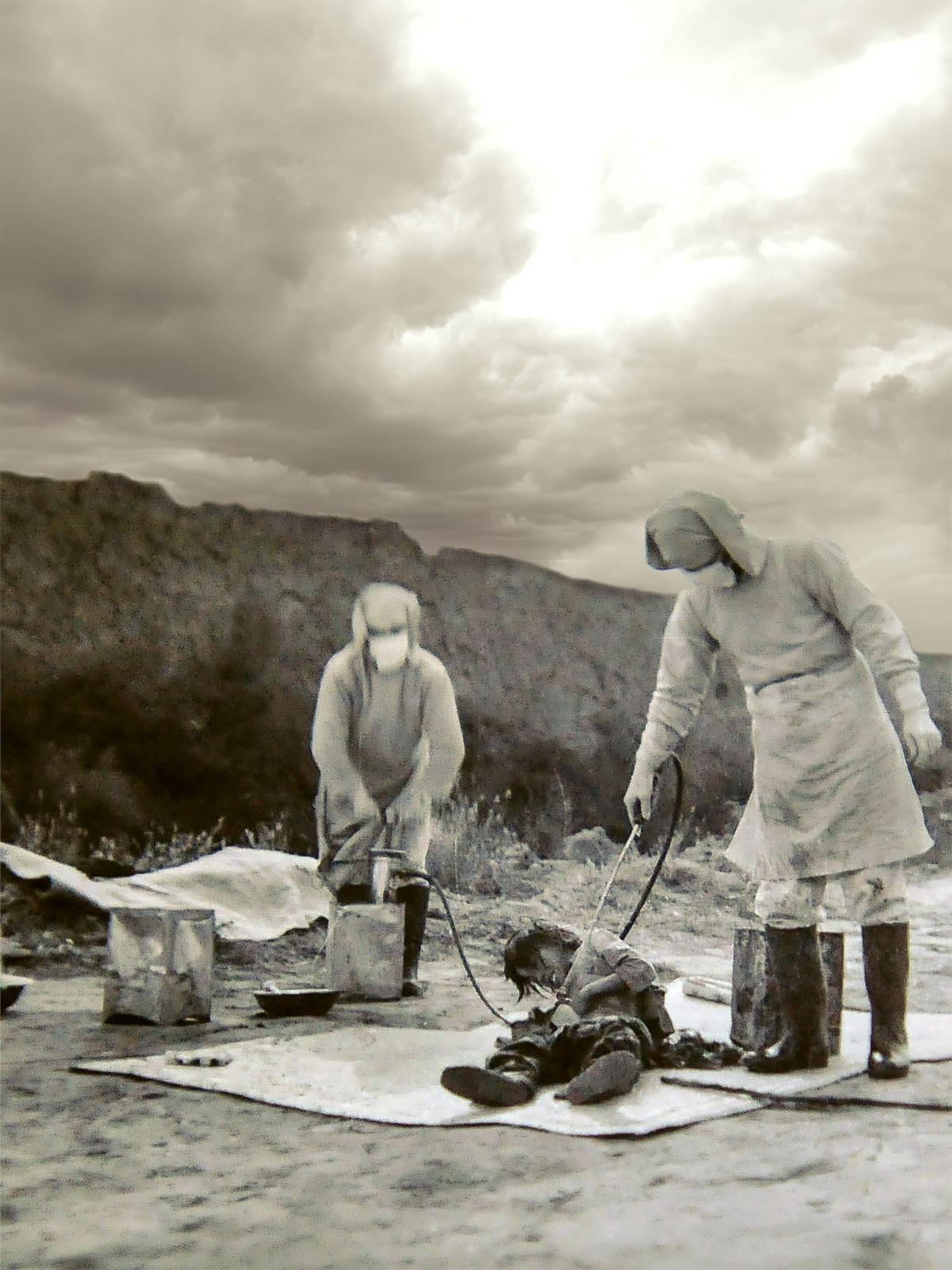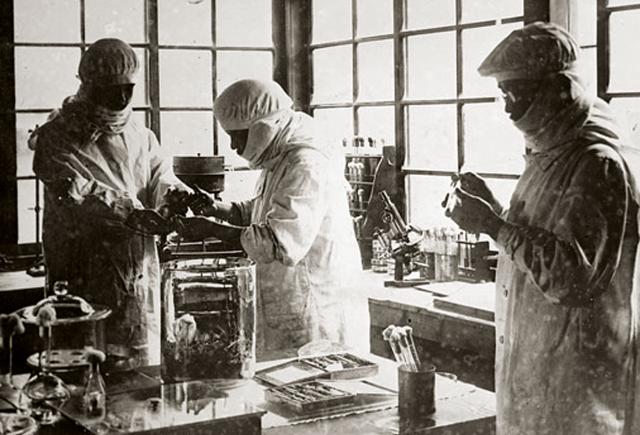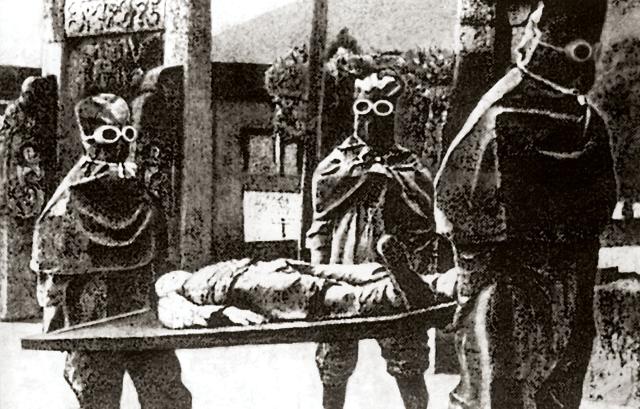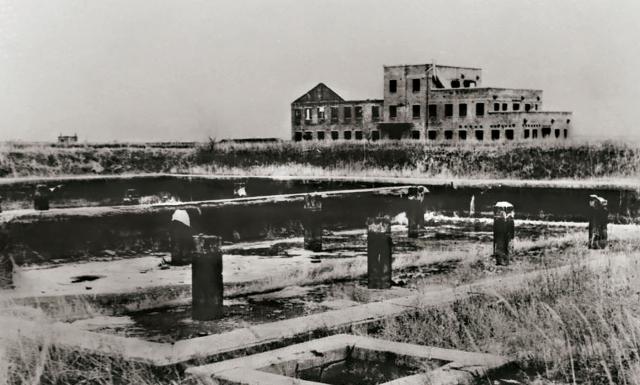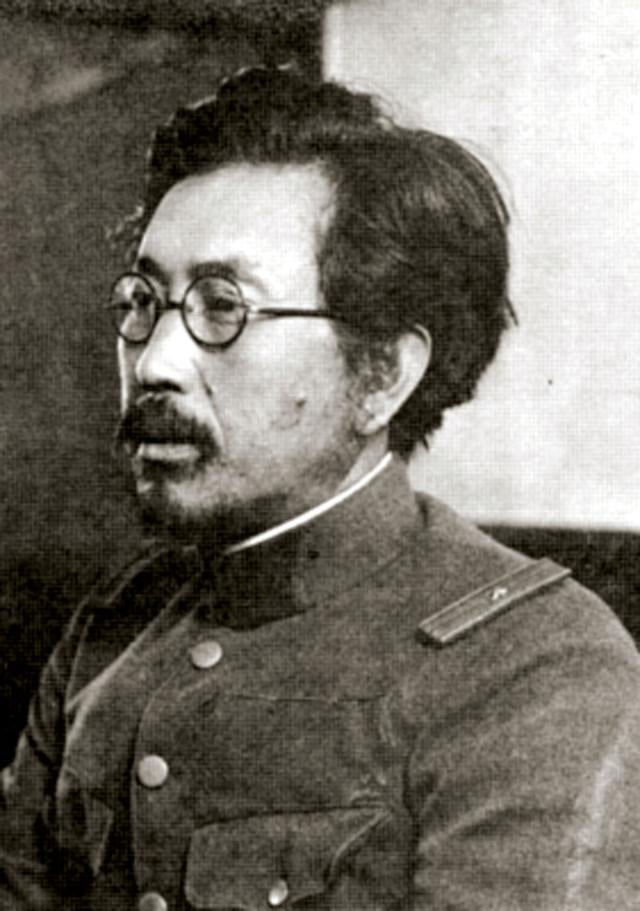During World War II three major antagonists—the United States, Germany, and Japan—all sought to develop “horror” weapons: an atomic bomb, chemical agents, and germ or biological weapons. Japan had two atomic bomb programs, one army and one navy, and a significant chemical warfare effort—but most terrifying was the Japanese biological weapon program.
While an instructor of epidemiology at the Army Medical College in Tokyo from 1931 to 1936, Shiro Ishii strongly advocated a biological weapons program. In that period, he became famous for developing a water-purification filter that replaced the awkward boiling procedures and the use of chlorine. Reportedly, “to demonstrate the effectiveness of the ‘Ishii filter,’ Ishii urinated into, then drank from its output. Army and navy chiefs attending Ishii’s bizarre presentation were duly impressed.”1 The device was adopted by the armed forces, and Emperor Hirohito was said to have seen it when visiting a naval ship. (Undoubtedly the Emperor did not sip filtered urine.)
Unit 731: Bio-Warfare Central
Shortly after taking control of Manchuria in 1931–32, the Japanese Army established a germ-warfare center in a factory outside the large city of Harbin. The secret biological warfare research facility—code-named Togo, to honor the Japanese admiral who defeated the Russians in the Battle of Tsushima Strait in 1905—had by the mid-1930s about 300 employees, of whom some 50 were scientists and physicians.
The center was funded from a secret budget and commanded by army officers. It was moved to a new, two-story building near the Harbin military hospital and, in mid-1936, Ishii arrived from Japan to take control of the biological warfare effort. At about that time, the facility was given the cover name Epidemic Prevention and Potable Water Supply Unit and, in 1941, the official designation Unit 731.
To the south, during the war with China that erupted in 1937, Ishii’s unit gained favorable attention within the army by providing water filtration machines to help combat an epidemic of cholera among Japanese troops. This led to Ishii’s specialists being assigned to most Japanese Army divisions. British historians have observed that Ishii’s men:
would have a presence in every battle zone, supplying water and dealing with epidemics. But when the time came they would also have an ideal training and the right tactical position to wage BW [biological warfare]. One of Ishii’s dreams would come true—doctors in combat alongside the glorious infantry.2
The efforts and size of Ishii’s unit grew rapidly—from a staff of perhaps 1,000 military and civilian personnel when Ishii took command, to some 3,000 scientists, technicians, and soldiers during the war. It was the world’s first major biological warfare installation. Over a two-year period, about 150 buildings were constructed at Pingfan, 15 miles south of Harbin, to house Unit 731.It rapidly became self-supporting, raising its own vegetables and livestock. Its complex included research and medical facilities, extensive production factories, animal kennels, power generators, a railroad siding, barracks, and dining halls, with a highly secure prison behind its surrounding walls.
A school also was provided to train specialists for service in army field units. Scientists and technicians working in laboratories and production rooms were provided with rubberized protective suits and respirators. The officers assigned to Pingfan received dangerous service pay, while enlisted men received additional food rations. The area around the sprawling Unit 731 facility—soon known as Togo—became one of the most affluent and modern villages in Manchuria.
Major branches of Unit 731 subsequently were established at several locations in the region. An expansive test area was provided for Unit 731’s weapons at Anta, on the remote plains of Manchuria. A seven-plane aviation detachment helped with field tests of biological weapons.
In 1940, Ishii was promoted to major general. Although he considered defensive concepts, his primary efforts were in offensive biological warfare: deploying plague, cholera, and typhoid and experimenting with how to cause frostbite and gas gangrene among enemy troops. Researchers at Pingfan used men and women as involuntary test subjects, causing them unspeakable pain and suffering as they were injected with germs, fed infected foods, and bitten by rodents and fleas. The testing of frostbite and other types of cold exposure on human subjects was equally appalling.
Human Guinea Pigs
The humans used in Ishii’s biological experiments are believed to have included around 3,000 Chinese, Koreans, and Manchurians. British sources contend that some of the American survivors of the 1942 Bataan Death March also were used. This has never been confirmed or denied by official U.S. sources, although documentation once existed and U.S. officers conducted extensive interviews with members of Ishii’s staff.
Australian prisoners, Manchurian bandits, and Japanese petty criminals also were reported to be among the test victims. Prisoners who survived the experiments were poisoned or shot when Soviet troops approached Pingfan in August 1945. Most of their bodies were then burned. At least 20 Japanese working at the facility also suffered infections, and a few died.
At its wartime peak, mass production of biological agents was under way at Pingfan, which is said to have had a productive capacity of eight tons of bacteria per month. Several methods of spreading these biological agents were considered, among them unleashing hordes of infected rats or fleas on enemy armies, dropping them from aircraft or in special bombs.
Standard bombs with metal casings could not be used, because the explosive needed to shatter the casing also would kill the infected fleas. Ishii then conceived the idea of porcelain bombs, which were produced at a Unit 731 facility in Harbin. The 55-pound missile carried fleas as well as oxygen to enable them to survive high-altitude flight. When fuses detonated the bomb it would shatter, spewing its deadly cargo of some 30,000 fleas, the casing bursting into minuscule fragments, leaving no trace.
After more than 2,000 of these bombs were tested, they were considered ready for operational use in 1944. Bombs carrying tetanus and anthrax bacilli were considered most appropriate for battlefield use, while typhoid and dysentery were thought more suitable for infecting troops in rear areas. Several other types of bombs for delivering germs were considered and tested, as well as such “unconventional” means of delivery as dropping infected feathers.
A notebook taken by U.S. troops in the Pacific told of a bacillus bomb for use against “cities, water reservoirs, animals, personnel.”3 There was, however, no evidence the bombs were in production. U.S. intelligence also recovered a secret order issued by the Navy Minister, Admiral Shigetaro Shimada, that “definitely connects the Jap Navy with Bacteriological Warfare.” The order discussed the pay of employees working on “chemical agents” at various naval facilities, defining “chemical agents” to include “Bacteriological Warfare agents,” thus indicating that the Imperial Japanese Navy also was heavily involved in the development of such weapons.4
Besides developing biological bombs, Ishii’s Unit 731 produced devices for individual plague infection through fountain pens and pointed walking sticks, and techniques for clandestinely poisoning drinking wells. The unit also developed a defoliation bacilli bomb that could destroy vegetation in an area of 20 square miles. Unit 731 experimented with (but discarded) artillery shells carrying gas as well as biological agents.
Germ-Spreading Balloons?
In another research project, Unit 731 looked into using balloons to spread germs. This was especially significant, because large balloons were developed and used to attack the United States. During 1944–45 the Japanese launched paper balloons carrying incendiary bombs to set fires in U.S. forests. The balloons were blown eastward from Japan at altitudes of 30,000 to 50,000 feet at speeds of 20 to 150 knots, and reached the United States and Canada from three to five days after launching.
A total of around 9,300 of these incendiary balloons were launched, although only a few successfully made the 6,200-mile Pacific crossing to the northwestern United States. U.S. Army specialists were concerned that the balloons were in fact carrying germs, but none of Ishii’s biological agents was used.5
Ishii’s biological warfare agents were used against China. On 4 October 1940, a lone Japanese plane circled over the town of Chuhsien in Chekiang Province and scattered rice and wheat grains believed to be flea-infected. A number of townspeople took ill, and 23 died of a plague-type illness. Three weeks later, there was another release of infected wheat grain over the port of Ningpo, and 99 persons succumbed to plague.
In a third incident, on 4 November 1941, a lone plane over Changteh in Hunan Province released wheat and rice grains, as well as pieces of paper and cotton that, upon scientific examination, appeared to have been infected. Plague also struck Changteh. These were areas that had not experienced plague in many decades.6 Several more strange flights of a single aircraft dropping apparently infected material were recorded over China. Traces of plague bacteria were found at some sites.
As war ranged in the Pacific, Ishii and Unit 731 were ready to wage biological warfare against the United States.7 There were reports that in June 1944, as U.S. troops assaulted Saipan in the Marianas, Ishii dispatched a 17-man team that was to land on Saipan and release plague-infected fleas. The ship carrying the specialists, however, was said to have been torpedoed and sunk by a U.S. submarine. There was one survivor of the team.
And, as the war was ending, Japanese Navy officers discussed launching aircraft from their large, I-400–class submarines to deliver biological weapons on U.S. coastal targets. Previously it had been planned to make conventional air attacks from the I-400s against New York City and then the Panama Canal. (The submarines—the largest nonnuclear undersea craft ever built—carried out no attack missions before the war ended.)
Grim Home-Island Options
The members of the Japanese high command had rejected the use of chemical
and biological weapons against U.S. forces in the Philippines, Iwo Jima, and Okinawa. But would they have rejected them on the beaches of Kyushu or Honshu had the atomic bombs not brought the war to an end and U.S. soldiers and Marines assaulted the Home Islands? There is virtually no evidence on either side of the question—except the fact that the landings at Kyushu were to be resisted by all possible means—to increase the number of American deaths so there still could be a negotiated end to the war. The use of horror weapons could have accomplished the goal of inflicting massive American casualties on the beaches.
The size of his budget, between 6 and 12 million yen per year (up to $5 million), and Ishii’s promotion to lieutenant general in 1945, suggest approval of Unit 731 and its activities by the highest military authorities.8 When the war ended in August 1945, Ishii tried to erase all traces of Unit 731. Efforts were made to destroy equipment, facilities, documents, and the human test subjects, with the unit’s Japanese personnel being given the highest priority for evacuation back to Japan before Soviet troops entered the area.
U.S. military officers interrogated Ishii and several of his senior officers after the war. They were not brought to trial as war criminals, although some Pingfan officers captured in Manchuria by the Soviets were tried. Ishii and officers from Unit 731 were granted immunity by the United States in exchange for information and research to help the U.S. biological warfare program. Ishii lectured at the Army’s chemical-biological research center at Camp Detrick, Maryland, in 1948.
Several countries developed horror weapons during the war. The United States considered them a means to reduce American casualties; the Japanese looked at them as a means to increase casualties—American ones.
1. Peter Williams and David Wallace, Unit 731: Japan’s Secret Biological Warfare in World War II (New York: Free Press, 1989), 11.
2. Williams and Wallace, Unit 731, 18.
3. War Department General Staff, Military Intelligence Service Research Unit, “Japanese Bacterial Bomb” Project No. 2244 (Washington, DC: 6 June 1945).
4. U.S. Army Forces Pacific Ocean Area, Headquarters, letter, “Bacterial Warfare Intelligence” (28 May 1945); the letter refers to the Joint Intelligence Center Pacific Ocean Area Item No. 16218.
5. Robert C. Mikesh, Japan’s World War II Balloon Attacks on North America (Washington, DC: Smithsonian, 1997), 67.
6. John W. Powell Jr., “Japan’s Biological Weapons, 1930–1945: A Hidden Chapter in History,” Bulletin of Atomic Scientists, October 1981, 44–53.
7. Williams and Wallace, Unit 731, 81.
8. Ishii was replaced as commander of Unit 731 sometime during the war by Major General Masaji Kitano so he could have the field assignment as medical officer for the First Army to be eligible for promotion to lieutenant general. When Ishii resumed command of Unit 731 in March 1945, Kitano remained as his deputy commander.



